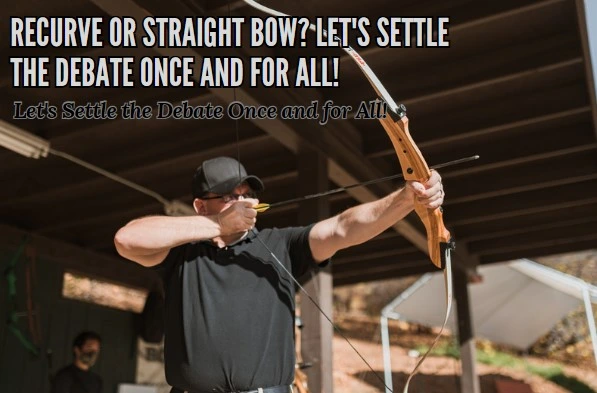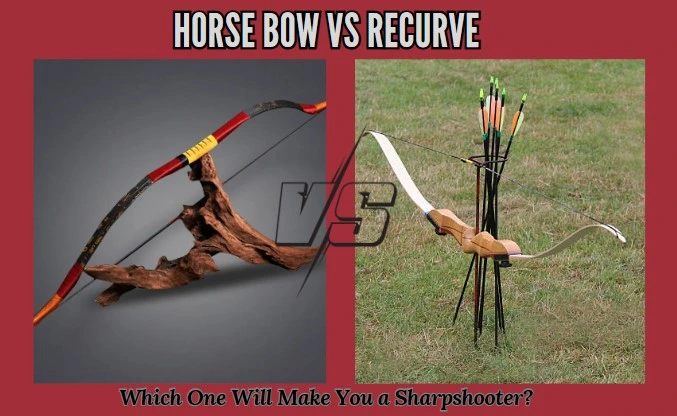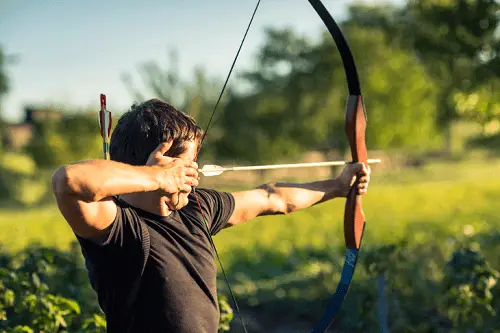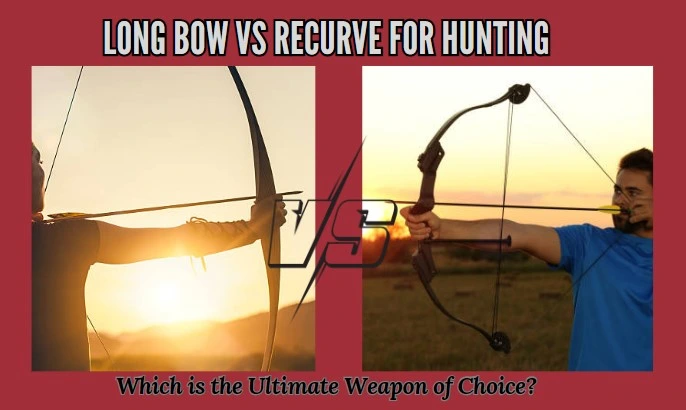Are you interested in archery but unsure which type of weapon to use? Recurve bows and crossbows are two popular choices for hunters and sports enthusiasts alike. Both have their unique advantages and disadvantages, and choosing between them can be a difficult decision.
In this article, we will compare and contrast the basic design, performance, accuracy, ease of use, safety considerations, versatility, and cost of recurve bows and crossbows.
We will also discuss the advantages and disadvantages of each weapon and provide tips for choosing the right one based on your personal preferences and needs. Whether you are a beginner or an experienced archer, this article will help you make an informed decision about which type of weapon is best for you.

Key Takeaways
- Recurve bows and crossbows are popular choices for hunters and sports enthusiasts.
- Recurve bows are more traditional and require more skill to use, while crossbows are easier to learn but less versatile.
- Choosing between these two weapons depends on personal preference and specific needs.
| Aspect | Recurve Bow | Crossbow |
| Design and Construction | – Lightweight and simple design | – More complex design with a stock and trigger |
| – Typically made from wood or composite material | mechanism | |
| – Fewer moving parts and easier to maintain | – Equipped with cables and anti-vibration systems | |
| – More durable and less likely to malfunction | – More difficult to maintain and repair | |
| Performance and Power | – Generally lower FPS and draw weight | – Higher FPS and draw weight |
| – Shorter power stroke | – Longer power stroke | |
| – Lower velocity and effective range | – Higher velocity and effective range | |
| Accuracy and Precision | – Requires good marksmanship skills | – Easier to achieve accuracy and precision |
| – Focus on form and practice | – Accuracy can vary with crossbow type | |
| Ease of Use and Maintenance | – Easier to use, especially for beginners | – Requires more strength and time to load |
| – Lightweight, easy to carry | – Heavier and less portable | |
| – Requires less maintenance | – More complex, harder to maintain | |
| Safety Considerations | – Generally safer due to lower power | – Can cause more serious injuries due to power |
| – Focus on proper form and trigger discipline | – Requires strict safety precautions | |
| Versatility and Purpose | – More versatile for sports, target shooting, | – Powerful, suitable for hunting and self-defense |
| and competitions | – Primarily used for hunting | |
| Cost and Budget | – Typically less expensive | – Generally more expensive |
| – Entry-level models available for lower cost | – High-end models with advanced features | |
| Portability and Size | – Smaller, lighter, easier to carry | – Bulkier and heavier, some collapsible options |
| Personal Preference | – Suitable for traditional shooting style | – Better for modern shooting style |
| – Quieter when shooting | – Offers more power and accuracy | |
| – Requires more skill to use effectively | – Easier to use, especially for beginners |
The Basics of Recurve Bow and Crossbow
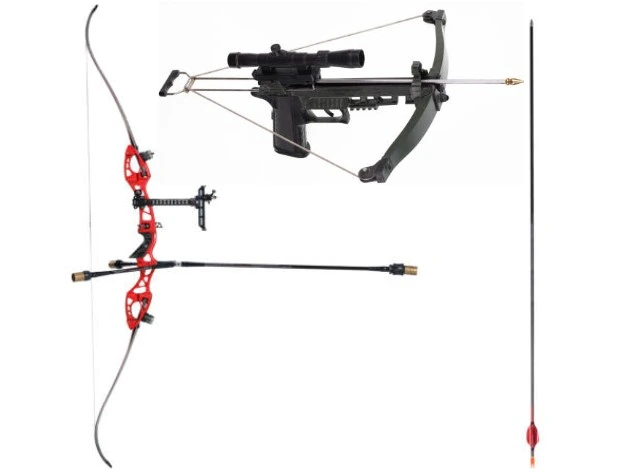
If you’re new to archery, you may be wondering what the difference is between a recurve bow and a crossbow. Both of these weapons are used for hunting and target shooting, but they have some key differences.
Let’s start with the recurve bow. This type of bow has been used for thousands of years and is still popular today. It gets its name from the way the limbs curve away from the archer. Recurve bows can be made from a variety of materials, including wood, fiberglass, and carbon fiber.
The limbs of a recurve bow are an important part of its design. They are curved to store energy when the bow is drawn, and then release that energy when the string is released. This gives the arrow more speed and power than a straight-limbed bow.
Now, let’s talk about the crossbow. Unlike a recurve bow, a crossbow uses a string and trigger mechanism to shoot arrows. This makes it easier to aim and shoot than a traditional bow, which requires more skill and practice.
Crossbows can also be more powerful than recurve bows, thanks to their compound design. This means that the limbs of the bow are connected by a system of pulleys and cables, which helps to reduce the amount of force needed to draw the string back. This makes it easier to shoot accurately and with more power.
In summary, recurve bows and crossbows are both great options for archers and hunters. Recurve bows are traditional and require more skill to use, but can be very powerful in the right hands. Crossbows are easier to use and can be more powerful, but are also more expensive and require more maintenance.
Comparing the Design and Construction
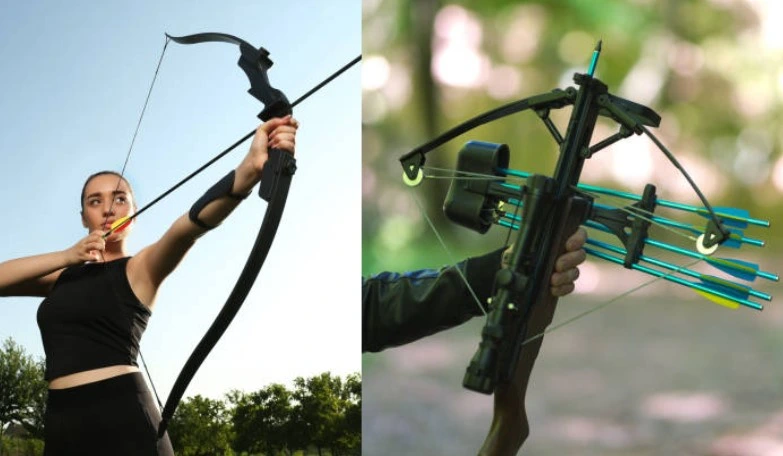
When it comes to the design and construction of recurve bows and crossbows, there are some key differences to consider. Let’s take a closer look at some of the most important factors.
Lightweight and Durable
Recurve bows are generally lighter than crossbows, which can make them easier to handle and maneuver. They are also simpler in design, with fewer moving parts, which makes them more durable and less likely to break or malfunction.
Construction and Stock
Recurve bows are typically made from a single piece of wood or composite material, with a curved shape that gives them their distinctive look. Crossbows, on the other hand, have a more complex construction, with a stock that holds the bow and a trigger mechanism that releases the arrow.
Cables and Anti-Vibration
Crossbows also have cables that help to pull the bowstring back and increase the power of the shot. However, these cables can add weight and complexity to the design. To counteract this, many crossbows are equipped with anti-vibration systems that reduce noise and recoil.
Complex Design
Overall, the design of a crossbow is more complex than that of a recurve bow, which can make them more difficult to maintain and repair. However, this complexity also allows crossbows to have greater power and accuracy than recurve bows, which can be an advantage in certain situations.
In summary, when comparing the design and construction of recurve bows and crossbows, it’s important to consider factors such as weight, durability, complexity, and power. While recurve bows are simpler and lighter, crossbows have a more complex design that can offer greater power and accuracy. Ultimately, the choice between the two will depend on your personal preferences and the specific needs of your hunting or shooting situation.
Performance and Power
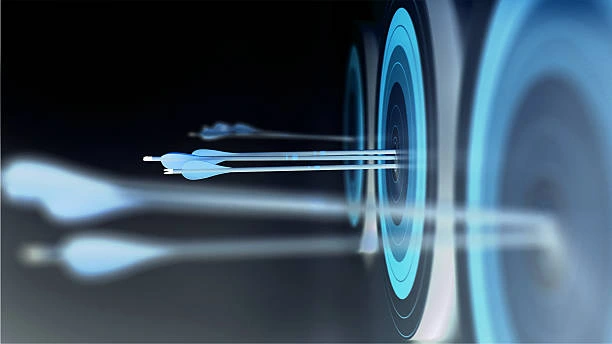
When it comes to choosing between a recurve bow and a crossbow, one of the most important factors to consider is performance and power. Both weapons can be deadly in the right hands, but they have different strengths and weaknesses.
Let’s start with the basics. FPS, or feet per second, is a measure of how fast an arrow or bolt travels through the air. Generally speaking, crossbows tend to have higher FPS than recurve bows, which means they can shoot arrows or bolts faster and with more force.
Power is another important factor to consider. Crossbows tend to be more powerful than recurve bows, which means they can shoot arrows or bolts with more kinetic energy. This can be especially important when hunting larger game, as you’ll need a weapon that can penetrate the animal’s hide and deliver a lethal shot.
Velocity is also an important consideration. Crossbows tend to have higher velocity than recurve bows, which means they can shoot arrows or bolts farther and with greater accuracy. This can be especially important when hunting in open areas where you need to take longer shots.
Another factor to consider is the power stroke. This is the distance the string travels from the rest position to the full draw position. Crossbows tend to have longer power strokes than recurve bows, which means they can generate more energy and shoot arrows or bolts with greater force.
Overall, when it comes to performance and power, crossbows tend to have the edge over recurve bows. However, this doesn’t mean that recurve bows aren’t powerful weapons in their own right. It all comes down to what you’re comfortable shooting and what you’re hunting.
Accuracy and Precision
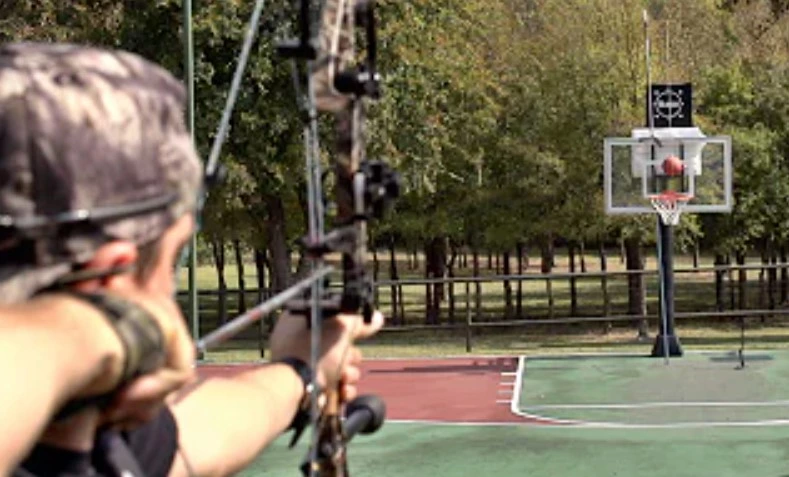
When it comes to archery, accuracy and precision are crucial. Both recurve bows and crossbows can be accurate and precise, but there are some differences to consider.
With a recurve bow, you need to focus on your marksmanship skills to achieve pinpoint accuracy. This means you need to have a steady hand, good form, and a lot of practice. With a crossbow, you can achieve accuracy and precision more easily, as the design of the crossbow allows for a more stable and consistent shot.
However, it’s important to note that a crossbow’s accuracy and precision can be affected by the type of crossbow you use. Some crossbows have a shorter power stroke, which can affect the speed and accuracy of the arrow. On the other hand, a recurve bow’s accuracy and precision can be affected by the draw weight and length of the bow.
To improve your accuracy and precision with either weapon, it’s important to focus on your form and marksmanship skills. This means practicing regularly, using proper techniques, and staying focused on your target.
In summary, both recurve bows and crossbows can be accurate and precise, but there are some differences to consider. With a recurve bow, you need to focus on your marksmanship skills to achieve pinpoint accuracy, while a crossbow’s design can make achieving accuracy and precision easier.
Ease of Use and Maintenance

When it comes to ease of use and maintenance, there is a clear winner between the recurve bow and crossbow. Recurve bows are generally easier to use and maintain than crossbows. Here’s why:
Ease of Use
Recurve bows are generally easier to use than crossbows. They are lighter, more maneuverable, and require less strength to shoot. This makes them a great choice for beginners or those who want to shoot for leisure. Recurve bows are also more versatile than crossbows. They can be used for target shooting, hunting, and even in competitions.
On the other hand, crossbows are heavier and require more strength to shoot. They also require more time to load, cock, and reload. This makes them less practical for beginners or those who want to shoot for leisure. Crossbows are also less versatile than recurve bows. They are mainly used for hunting and are not allowed in some competitions.
Maintenance
When it comes to maintenance, recurve bows are also easier to maintain than crossbows. Recurve bows have fewer moving parts and are easier to disassemble and reassemble. This makes them easier to clean and repair. Recurve bows also require less maintenance than crossbows. They do not require any special lubricants or cleaning solutions.
Crossbows, on the other hand, have more moving parts and are more difficult to disassemble and reassemble. This makes them more difficult to clean and repair. Crossbows also require more maintenance than recurve bows. They require special lubricants and cleaning solutions to keep them in good working order.
In conclusion, when it comes to ease of use and maintenance, recurve bows are the clear winner. They are easier to use, more versatile, and require less maintenance than crossbows. If you are a beginner or want to shoot for leisure, a recurve bow is the way to go.
Safety Considerations

When it comes to archery, safety should always be a top priority. Whether you’re using a recurve bow or a crossbow, there are certain safety considerations you need to keep in mind to ensure that you and those around you stay safe.
First and foremost, always make sure that your bow or crossbow is secure and in good condition before use. Check for any cracks or damage to the limbs, string, or trigger mechanism, and make sure that all screws and bolts are tightened properly. Failure to do so can result in serious injury or even death.
Another important safety consideration is trigger discipline. Always keep your finger off the trigger until you are ready to shoot. This can help prevent accidental discharge and ensure that you have full control over your bow or crossbow at all times.
Injury rates are also a consideration when choosing between a recurve bow and a crossbow. While both types of bows can be safe when used properly, crossbows have been known to cause more serious injuries due to their higher velocity and power. If you’re new to archery or have concerns about safety, a recurve bow may be the safer choice.
Overall, whether you choose a recurve bow or a crossbow, it’s important to practice good safety habits and to always be aware of your surroundings. With the right precautions and a little bit of common sense, you can enjoy the sport of archery safely and responsibly.
Versatility and Purpose
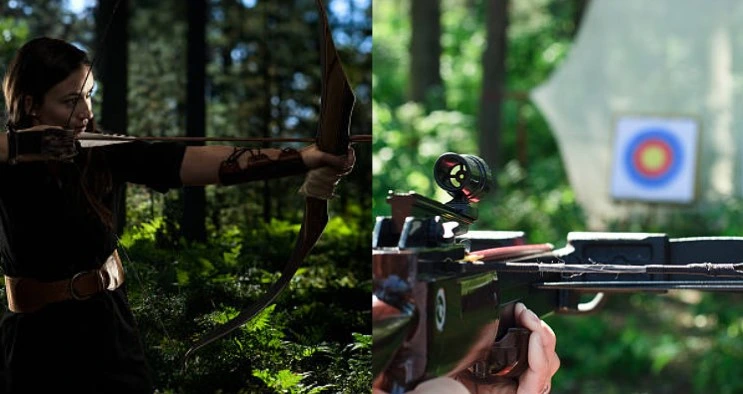
When it comes to choosing between a recurve bow and a crossbow, one of the most important factors to consider is versatility. Both weapons have their own unique strengths and weaknesses, and understanding these differences will help you determine which one is best for your needs.
First, let’s talk about purpose. If you’re looking for a weapon that can be used for self-defense, a crossbow is probably your best bet. Crossbows are generally more powerful than recurve bows, and they can be fired accurately from a distance. However, if you’re looking for a weapon that can be used for sport or target shooting, a recurve bow might be a better choice. Recurve bows are more lightweight and easier to maneuver, making them ideal for these types of activities.
Next, let’s talk about versatility. Recurve bows are generally more versatile than crossbows, as they can be used for a wider range of activities. For example, you can use a recurve bow for sport, target shooting, and bow hunting. Crossbows, on the other hand, are generally only used for hunting and self-defense.
When it comes to bow hunting, both recurve bows and crossbows can be effective. However, crossbows are generally more powerful and accurate, making them a better choice for larger game. Recurve bows, on the other hand, are more lightweight and easier to maneuver, making them a better choice for smaller game.
In summary, when choosing between a recurve bow and a crossbow, it’s important to consider your purpose and the versatility of the weapon. If you’re looking for a weapon that can be used for self-defense, a crossbow is probably your best bet. If you’re looking for a weapon that can be used for a wider range of activities, a recurve bow might be a better choice.
Cost and Budget Considerations
When it comes to purchasing a recurve bow or crossbow, cost and budget are important considerations. Both types of weapons come in a wide range of prices, so it’s important to figure out how much you’re willing to spend before making a purchase.
Recurve bows are generally less expensive than crossbows, with prices ranging from around $100 to $500 or more. Entry-level models can be found for around $100, while higher-end models with more advanced features can cost upwards of $500.
Crossbows, on the other hand, tend to be more expensive than recurve bows. Prices for crossbows can range from around $200 to $2,000 or more. Entry-level models can be found for around $200, while high-end models with advanced features can cost upwards of $2,000.
When considering cost and budget, it’s important to keep in mind that additional accessories may be necessary for both types of weapons. For example, arrows or bolts, a quiver, and a target are all essential accessories for a recurve bow or crossbow. These accessories can add to the overall cost of the weapon.
Overall, when it comes to cost and budget considerations, a recurve bow may be a more affordable option for those on a tight budget. However, if you’re willing to spend more money, a crossbow may be a better choice, as it offers more advanced features and capabilities. Ultimately, the decision comes down to your personal preferences and budget.
Portability and Size
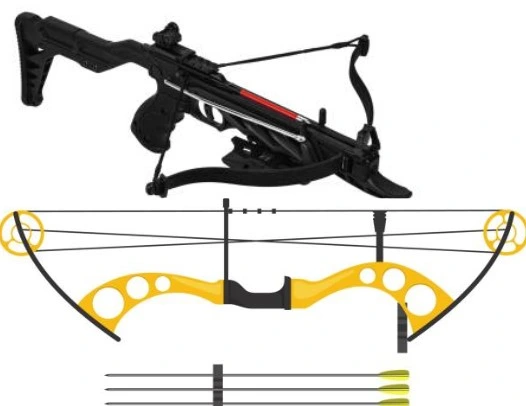
When it comes to archery equipment, portability and size are important factors to consider. If you’re someone who enjoys hunting in remote areas or needs to travel frequently with your equipment, then you’ll want something that’s easy to transport.
Recurve Bow
Recurve bows are generally more portable than crossbows. They are lightweight and easy to carry around, making them a great choice for hunters who need to move around quickly. Additionally, recurve bows are smaller in size, which means they can be stored in smaller spaces.
Crossbow
Crossbows, on the other hand, are bulkier and heavier than recurve bows. They are not as easy to transport as recurve bows and require more space for storage. However, some crossbows come with collapsible limbs, which makes them more portable.
Comparison
In terms of portability and size, recurve bows have the advantage over crossbows. They are smaller, lighter, and easier to carry around. However, if you’re willing to sacrifice some portability for power and accuracy, then a crossbow might be the better choice for you.
When choosing between a recurve bow and a crossbow, it’s important to consider your specific needs and preferences. If you need something that’s easy to transport and store, then a recurve bow is the way to go. However, if you need something that’s more powerful and accurate, then a crossbow might be the better choice.
Advantages and Disadvantages
When it comes to choosing between a recurve bow and a crossbow, there are advantages and disadvantages to both. In this section, we’ll explore the pros and cons of each option.
Recurve Bow Advantages
One of the biggest advantages of a recurve bow is its simplicity. It has a basic design and doesn’t require any additional components like a crossbow. This makes it lighter and easier to carry around with you. It’s also a more affordable option than a crossbow.
Another advantage of a recurve bow is that it’s quieter than a crossbow. This is because it doesn’t have any moving parts that make noise when you shoot. This makes it a great option if you want to hunt without disturbing the animals around you.
Recurve Bow Disadvantages
One of the biggest disadvantages of a recurve bow is that it requires more skill to use effectively. You need to have good form and technique to shoot accurately and consistently. This takes time and practice to develop.
Another disadvantage of a recurve bow is that it has a lower draw weight than a crossbow. This means it’s not as powerful and has a shorter effective range. You’ll need to get closer to your target to make an effective shot.
Crossbow Advantages
One of the biggest advantages of a crossbow is its power. It has a higher draw weight than a recurve bow, which makes it more effective at longer ranges. It’s also easier to use than a recurve bow, which makes it a great option for beginners.
Another advantage of a crossbow is that it’s more compact than a recurve bow. This makes it easier to store and transport. It’s also easier to shoot from a small space like a tree stand.
Crossbow Disadvantages
One of the biggest disadvantages of a crossbow is its weight. It’s heavier than a recurve bow, which can make it more difficult to carry around with you. It’s also more expensive than a recurve bow, which can be a barrier to entry for some people.
Another disadvantage of a crossbow is that it’s louder than a recurve bow. This is because it has moving parts that make noise when you shoot. This can be a disadvantage if you want to hunt without disturbing the animals around you.
Overall, both recurve bows and crossbows have their advantages and disadvantages. It’s important to consider your individual needs and preferences when choosing between the two.
Choosing Based on Personal Preference
When it comes to choosing between a recurve bow and a crossbow, personal preference plays a significant role. Both have their advantages and disadvantages, and it’s up to you to decide which one is better for you. Here are a few tips to help you make an informed decision based on your personal preferences:
Shooting Style
If you prefer a more traditional shooting style, then a recurve bow may be the ideal choice for you. Recurve bows are lightweight, easy to carry, and easy to handle. They require a bit more skill to shoot accurately, but they can be incredibly rewarding once you master them.
On the other hand, if you prefer a more modern shooting style, then a crossbow may be a better fit. Crossbows are easier to shoot accurately, and they require less skill than recurve bows. They are also more powerful and have a longer range, making them ideal for hunting.
Longevity
When it comes to longevity, both recurve bows and crossbows can last a long time if properly maintained. However, crossbows tend to require less maintenance than recurve bows, making them more convenient for those who don’t have a lot of time to maintain their equipment.
Ideal for Hunting
Both recurve bows and crossbows are ideal for hunting, but they have their differences. Recurve bows are quieter and more lightweight, making them better for hunting smaller game. Crossbows, on the other hand, are more powerful and have a longer range, making them better for hunting larger game.
Personal Preference
At the end of the day, the choice between a recurve bow and a crossbow comes down to personal preference. It’s important to try both before making a decision and see which one feels more comfortable and natural to you. Remember, the best bow or crossbow for you is the one that you can shoot accurately and enjoy using.
Overall, both recurve bows and crossbows have their advantages and disadvantages, and it’s up to you to decide which one is better for you based on your personal preferences.
Conclusion
You’ve now learned about the differences between recurve bows and crossbows, and hopefully, you have a better understanding of which one is right for you.
Whether you’re a beginner or an experienced archer, both types of weapons have their advantages and disadvantages.
Recurve bows are lightweight, easy to maneuver, and require less maintenance than crossbows. They’re also more accurate and have a faster reload time. However, they require more skill to use effectively and have a shorter range than crossbows.
Crossbows, on the other hand, are more powerful and have a longer range. They’re also easier to use and require less physical strength. However, they’re heavier, bulkier, and require more maintenance than recurve bows.
Ultimately, the decision between a recurve bow and a crossbow comes down to personal preference and what you plan to use it for. If you’re looking for a weapon that’s easy to use and requires less skill, a crossbow might be the better choice. If you’re looking for a challenge and want to hone your archery skills, a recurve bow might be the way to go.
No matter which one you choose, remember to always practice safety and follow the rules and regulations in your area. Happy shooting!
Frequently Asked Questions
What are the advantages of using a recurve bow over a crossbow?
Recurve bows are lightweight and easy to carry, making them ideal for hunting and outdoor activities. They also provide a more traditional archery experience, allowing you to connect with the sport’s roots. In addition, recurve bows are quiet and do not require a lot of maintenance.
What are the benefits of using a crossbow instead of a recurve bow?
Crossbows are easier to use than recurve bows and require less skill to shoot accurately. They also have a longer effective range and are more powerful, making them ideal for hunting large game. Crossbows are also more forgiving than recurve bows, allowing you to make mistakes without sacrificing accuracy.
What makes a recurve crossbow different from a traditional recurve bow?
A recurve crossbow is essentially a hybrid between a crossbow and a recurve bow. It features a recurve bow’s limbs and a crossbow’s trigger mechanism, allowing you to shoot arrows with the power and accuracy of a crossbow. Recurve crossbows are typically smaller and lighter than traditional crossbows, making them easier to handle and transport.
What are the key differences between a compound bow and a crossbow?
Compound bows use a system of pulleys and cables to bend the limbs and store energy, while crossbows use a trigger mechanism to release the limbs and shoot arrows. Compound bows are typically faster and more accurate than crossbows, but they require more skill to use effectively. Crossbows are easier to use and require less maintenance than compound bows.
What are some of the top-rated recurve bows on the market?
Some of the top-rated recurve bows on the market include the Samick Sage, the Bear Archery Super Kodiak, and the Martin Saber. These bows are known for their quality craftsmanship, accuracy, and ease of use.
What are the best crossbows for hunting and target shooting?
Some of the best crossbows for hunting and target shooting include the TenPoint Turbo GT, the Barnett Ghost 420, and the Excalibur Matrix Bulldog 400. These crossbows are known for their power, accuracy, and reliability, making them ideal for a variety of outdoor activities.

Archery is my hobby & I usually hunt and play on weekends and after work. It’s a passion since I was very young and I love writing about it as well to continuously learn more and share the love of archery with others!

